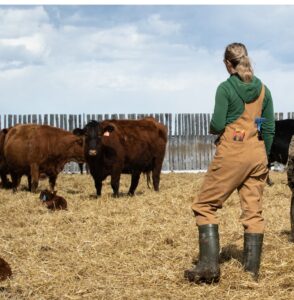Keep Your BVD Down 🎙️
CLICK THE PLAY BUTTON TO LISTEN TO THIS POST:
Listen to more episodes on BeefResearch.ca, Spotify, Apple Podcasts, Amazon Music or Podbean.
This article written by Dr. Reynold Bergen, BCRC Science Director, originally appeared in the August 2025 issue of Canadian Cattlemen magazine and is reprinted on BeefResearch.ca with permission of the publisher.

Canada’s first cases of “X disease” were described in Saskatchewan in the summer of 1946. It was eventually renamed bovine viral diarrhea (BVD). But that isn’t the best name either, because diarrhea isn’t the big problem. The bigger concerns are abortion, infertility, immune system suppression and calf death.
Persistently infected (PI) calves occur when BVD virus crosses the placenta during the first four months of gestation. Because the BVD virus is already present before the PI calf’s immune system starts to develop, the virus isn’t recognized as foreign, and the calf never mounts a protective immune response to eliminate it. Before they die, PI calves can shed large amounts of BVD virus, infect susceptible cattle and cause illness ranging from a mild fever to abortion, premature births, deformities, stunted growth and death.
Cheryl Waldner and collaborators at the Universities of Saskatchewan, Calgary and Montreal recently assessed the prevalence of BVD virus in weaned beef calves and whether antibodies against BVD varied among vaccination programs (Bovine viral diarrhea virus and virus-neutralizing antibody titers in beef calves at or near fall weaning; PMC12044622).
What They Did
At weaning in 2021, blood samples were collected from about 20 spring-born calves in each of the 107 commercial beef herds participating in the Canadian Cow-Calf Surveillance Network. A total of 1,934 calves were sampled out of the 21,069 calves weaned from these herds. The research team looked for BVD virus and anti-BVD antibodies in the serum. Cooperating herds also shared their vaccination records, and the relationship between BVD vaccination practices and BVD virus and anti-BVD antibody levels were determined.
What They Learned
BVD vaccines work!
Vaccination practices: In the previous year, 95% of the herds had vaccinated their breeding cows against BVD, 80% vaccinated calves, and 27% gave calves a booster before weaning.
Antibodies against BVD: More than 80% of calves had detectable level of antibodies against BVD, a statistic that is remarkably similar to the 80% of herds that had vaccinated their calves against BVD at least once before weaning (above). The calves were sampled at weaning, long after the maternal antibodies from colostrum would have declined in the bloodstream, so it’s almost certain that the antibodies detected were from the vaccine. They could also be from natural infection, but that’s unlikely because only four calves from three herds tested positive or suspect for BVD.
BVD virus: A total of three calves from two different herds were confirmed positive for BVD virus. A fourth calf from a third herd was suspect. It’s impossible to know whether these calves were persistently (PI) or transiently infected without a follow-up test a few weeks later to see if the BVD virus was still present (PI) or if it had been effectively cleared by the immune system (transient). But if we assume all four of these calves from these three herds were PI (the worst-case scenario), the herd-level prevalence would be 2.8% (three herds with positive or suspect calves out of 107 herds) and the animal-level prevalence would be 0.2% (four calves out of 1,934). Older and smaller studies have reported a much higher herd- and animal-level BVD prevalences, suggesting that BVD vaccination practices (and/or vaccine effectiveness) have improved in Canada.
Relating vaccination practices to BVD virus and antibody levels: Two of the BVD-positive calves were unvaccinated but born in a cow herd that had been vaccinated and boosted the previous year. The third positive calf had been vaccinated (but not boosted) and born in a cow herd that been vaccinated once (not boosted) the previous year. Anti-BVD antibody levels were very low in all the calves from both of those herds. The suspect calf was from a herd that vaccinated calves twice before weaning, and that vaccinated the breeding females once. The suspect calf also had much lower levels of anti-BVD antibodies than the other calves in that herd. Perhaps it was a late-born calf that missed one or both vaccination events.
When anti-BVD antibodies were related to vaccination practices across all calves and herds sampled, calves that had been vaccinated once or twice (and born to vaccinated dams) had significantly higher levels of anti-BVD antibodies than unvaccinated calves born to vaccinated dams.
What Does This Mean To You?
Vaccination can control BVD very effectively, and continued vaccination continues to control it. Low animal- or herd-level BVD prevalence is not a reason to stop vaccinating for BVD. If you’re already vaccinating against BVD, continue to do so. If you’re not vaccinating against BVD yet, start. If you’re buying heifers to expand your herd, quarantine them for two to four weeks and vaccinate them before mixing with your herd, especially if you’re unfamiliar with their BVD vaccination status.

Canada’s current measles situation illustrates why. Canada declared human measles “eliminated” (not eradicated) in 1998 because vaccination rates were high enough and case numbers were low enough (17 cases nationwide) that the virus wasn’t able to spread easily. Recently, the number of Canadian measles cases went from 12 in 2023, to 147 in 2024 and 2,698 by the end of May 2025. Over 90% of the current cases are in people who haven’t been vaccinated (or have unknown vaccination status). The same thing could happen with BVD if we take our eyes off the ball, with very costly consequences for individual producers, herds and the industry.
Bottom Line
Now is a good time to talk to your veterinarian to review your herd health program and to ensure that the vaccines you’re using, how they’re stored and handled, which cattle receive them and when, is still appropriate.
The Beef Cattle Research Council is a not-for-profit industry organization funded by the Canadian Beef Cattle Check-Off. The BCRC partners with Agriculture and Agri-Food Canada, provincial beef industry groups and governments to advance research and technology transfer supporting the Canadian beef industry’s vision to be recognized as a preferred supplier of healthy, high-quality beef, cattle, and genetics. Learn more about the BCRC at www.beefresearch.ca.
Click here to subscribe to the BCRC Blog and receive email notifications when new content is posted.
The sharing or reprinting of BCRC Blog articles is typically welcome and encouraged, however this article requires permission of the original publisher.
We welcome your questions, comments and suggestions. Contact us directly or generate public discussion by posting your thoughts below.